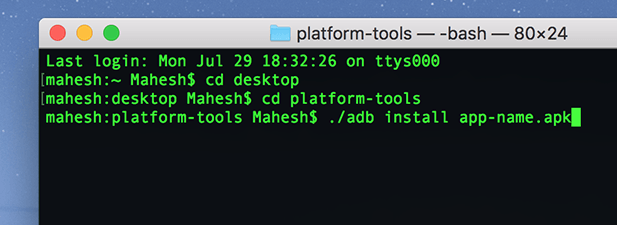
- #ADB SHELL LIST DIRECTORY CONTENTS INSTALL#
- #ADB SHELL LIST DIRECTORY CONTENTS SOFTWARE#
- #ADB SHELL LIST DIRECTORY CONTENTS PASSWORD#
#ADB SHELL LIST DIRECTORY CONTENTS PASSWORD#
Then confirm the process on your device's display and provide a password whether a backup password has been set before. $ adb backup -apk -shared -all -f backupFileName.abĪdb backup The commands below led to backup your device to a single file which can also be successively restored. Moreover, no root is required to follow the process. You can also backup and restore your device with adb. You can now use adb to transfer files between the device and your computer.

If you still do not see the 'Allow USB Debugging?' dialog, and the device is listed as unauthorized, then enter the Developer Options on the device and first uncheck "USB Debugging" and then check it again. If the dialog was never presented, try Settings > Developer Options > Revoke USB Debugging Authorizations (then "OK"), and repeat the steps in this section. A 'Allow USB Debugging?' dialog should be presented when you physically connect the device. If adb devices still shows "unauthorized" next to your device, make sure that that device has debugging permission allowed on the device itself. If adb still does not detect the device after plugging your device back in, kill and restart the adb server as root and check devices again: Make sure you are member of adbusers user group to access adb devices.Īfter you have setup the udev rules, unplug your device and replug it.

Then, to reload your new udev rules, execute: etc/udev/rules.d/les SUBSYSTEM="usb",ATTR="",SYMLINK+="android_fastboot" Copy these rules into /etc/udev/rules.d/les:
#ADB SHELL LIST DIRECTORY CONTENTS INSTALL#
Use the rules from android-udev (or android-udev-git AUR), install them manually from Android developer, or use the following template for your udev rules, just replace and with yours. An example for HTC Evo is:īus 002 Device 006: ID 0bb4:0c8d High Tech Computer Corp. Otherwise see the instructions below.Įach Android device has a USB vendor/product ID. If ADB recognizes your device ( adb devices shows it as "device" and not as "unauthorized", or it is visible and accessible in IDE), you are done. Reboot the phone after checking this option to make sure USB debugging is enabled.
#ADB SHELL LIST DIRECTORY CONTENTS SOFTWARE#
Build number may be under a menu called Software info on newer Android OS versions.


Make sure your USB cable is capable of both charge and data.Many devices' udev rules are included in libmtp, so if you have this installed, the following steps may not be necessary.Some other devices require enable PTP mode to work. For some devices, you may have to enable MTP on the device, before ADB will work.


 0 kommentar(er)
0 kommentar(er)
